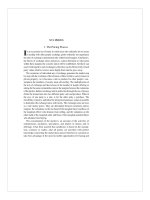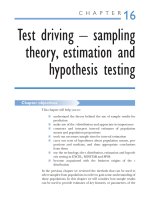Crisis intervention strategies chapter 16
Bạn đang xem bản rút gọn của tài liệu. Xem và tải ngay bản đầy đủ của tài liệu tại đây (42.51 KB, 10 trang )
Chapter Sixteen: Human
Services Workers in Crisis:
Burnout, Vicarious
Traumatization, and
Compassion Fatigue
Helping Professionals: Prime
Candidates
Nature
of the job is to be intensely involved with
people who are in need of assistance.
Recipe
for burnout:
High levels of motivation
Idealistic
Expectation that their work will give their life a sense of
meaning
Many
helping professions have historically low
success rates.
Human
service field is becoming more difficult .
Defining Burnout
Historical
“Burned out” physically, emotionally, spiritually,
interpersonally, and behaviorally to the point of exhaustion.
Herbert
Freudenberger (1974, 1975)
Described young, idealistic volunteers working in alternative
health-care settings who started to look and act worse than
many of their clients.
Burnout
roots from the 1970s
consists of the following:
Lost energy to the point of exhaustion
Lost enthusiasm to the point of absolute indifference
Passion is replaced by cynicism
Complete lack of confidence that your work is having any
positive impact
Dynamics of Burnout
Foundation
Blocks of Burnout
Role ambiguity
Role conflict
Role overload
Inconsequentiality
Isolation
Autonomy
Symptoms of Burnout
Behavioral
Physical
Interpersonal
Attitudinal
Dynamics of Burnout Cont.
Stages
of Burnout
Enthusiasm
Stagnation
Frustration
Apathy
The Culpability of
Organizations
Much
of the responsibility lies with the employer.
Employee’s influence on policy and procedures
Employee’s level of autonomy
Employee’s feeling of appreciation
Employers
should provide consultation and
supervision.
Employers
should offer support, social connection,
and self-care opportunities.
Self-Recognition of Burnout
NO
ONE IS IMMUNE!
Everyone
Typical
has a blind spot.
MO is to increase effort (actually
increases the problem) rather than attempting to
change the situation.
Intervention Strategies
Assessment
Burnout
Compassion Fatigue and Compassion Satisfaction
Work Environment
Intervention
Through Training
Intervention
With the Organization
Burnout-Proofing an Agency
Social Support Systems
Support Groups
The Individual and the Organization
Self-Care
Private Practitioners and
Burnout
Isolation
Business
Concerns
Financial
Client base
Marketing services
Maintaining
Difficult
a Public Presence
Work Schedule
Evenings
Weekends
Few vacations
INTERVENTION WITH THE
INDIVIDUAL
Direct
Action
Palliative (quick fix) Action
BASIC IDS
Behavior
Affect
Sensation
Imagery
Cognition
Interpersonal relationships
Drugs/biology
Setting









